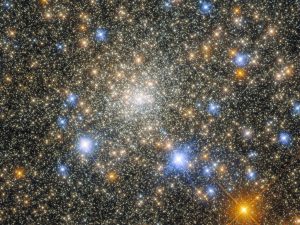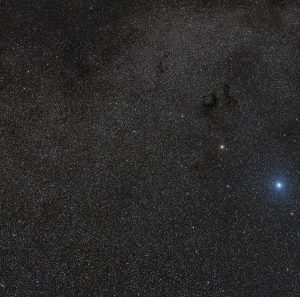2022 August 3
Deep Sky Update – July 2022
It’s nice to see the darker nights returning, though I can’t say I have had any particularly good nights here over the past few weeks. I have been dismantling my kit ready for moving house, so I would not have been able to do much ‘serious’ observing but I had hoped to get out with binoculars.
It was fantastic to see the first light images from the James Webb Space Telescope. I especially liked the image of Stephan’s Quintet. As a taste of things to come, it will be a real game changer for professional astronomy.
The ages of Globular Clusters

Image credit: ESA/Hubble & NASA, R. Cohen
Alan Thomas noted on his members’ album image of M107 that the age of this GC is given as 13.95 Gyr. which as noted by Grant Privett is somewhat older than the accepted age of the Universe of 13.787±0.020 Gyr. 13.95 Gyr for M107 is given on its Wikipedia page and is taken from a 2010 paper by Forbes and Bridges in Monthly Notices of the Royal Astronomical Society [1]. In this paper M107 (NGC 6171) is one of the oldest, surpassed only by Lynga 7 at 14.46 Gyr. The paper makes no comment on these very old ages, which both come from another paper by Marin-Franch et al. (2009) [2]. However the paper by Marin-Franch et al. reports relative ages rather than absolute ages – so it’s not clear how the 13.95 Gyr number has been arrived at, except by using another GC to determine an age offset.
When browsing through the papers on M107 though, the most recent dedicated to the ages of GCs which includes M107 seems to be that by Don A. VandenBerg et al [3]. It is interesting to note a specific comment against M107 in this paper which notes that it “suffers from significant differential reddening” – which might account for the large ages attributed to M107. However in VandenBerg’s paper the age of M107 is given as 12.00 ±0.75 Gyr, which certainly passes the age of the universe test.
One technique for determining the age of a globular cluster essentially involves making a Hertzsprung-Russell (aka Colour-Magnitude) diagram for the GC, and then modelling this against a theoretical distribution of stars that were created at the same time. As a GC is a closed system (there is no more star formation going on) the massive stars will evolve away, and ‘normal’ stars will evolve along the main sequence. By analysing the distribution of stars, the age can be estimated. At one time it was thought that all the stars in a GC were created at the same time, but recent studies indicate that most GCs have multiple phases of star formation, so the modelling of the age is somewhat more complicated.
In looking at papers on M107 over the past few years, most papers concern the dynamics of globulars – either their movement around the galaxy, or the motion of stars in the GC itself. There does not seem to be much recent research on the ages of GCs. But if anyone comes across any recent research I would certainly like to hear of it.
Finally, although JWST is much in the news, it should not be forgotten that the Hubble Space Telescope is still working, and recently published this terrific image of the GC Terzan 2 in Scorpio.
https://www.nasa.gov/image-feature/goddard/2022/hubble-snaps-a-portrait-of-a-globular-cluster
[1] Forbes, Duncan A.; Bridges, Terry (May 2010), “Accreted versus in situ Milky Way globular clusters”, Monthly Notices of the Royal Astronomical Society, 404 (3): 1203–1214, arXiv:1001.4289,
https://arxiv.org/pdf/1001.4289.pdf
[2] The ACS Survey of Galactic Globular Clusters. VII. Relative Ages Marin-Franch et al. 2009, ApJ, 694, 1498
https://ui.adsabs.harvard.edu/abs/2009ApJ…694.1498M/abstract
[3] THE AGES OF 55 GLOBULAR CLUSTERS AS DETERMINED USING AN IMPROVED METHOD ALONG WITH COLOR–MAGNITUDE DIAGRAM CONSTRAINTS, AND THEIR IMPLICATIONS FOR BROADER ISSUES
Don A. VandenBerg, K. Brogaard, R. Leaman and L. Casagrande
The Astrophysical Journal, Volume 775, Number 2
https://iopscience.iop.org/article/10.1088/0004-637X/775/2/134
July Object of Interest – Barnard’s ‘E’

Many thanks to all those that had a go at Barnard’s E – it seems to have been popular. Images were taken by Iain Cartwright, Brad Thomas, Kevin Gurney, Mazin Younis, and Alun Halsey. Iain’s image at right here was taken with Nikon D810A and Sigma 150mm macro lens, 155 sub exposures of 30s at ISO 800.
Brad also took an image in near-infrared too which is interesting – see https://britastro.org/observations/observation.php?id=20220717_185221_df2d6b433bd4c058
You can check out the images on the OOI page: https://britastro.org/section_information_/deep-sky-section-overview/object-of-interest-gallery
Object of Interest for August
This month’s target is the supernova remnant Sharpless 2-91 in Cygnus. The Veil Nebula is of course well known and observed, rather overshadowing Sh 2-91 and the other nebulosity in that area. It is somewhat fainter than the Veil, though, making visual observation difficult (a 10 inch aperture scope of more, and an OIII filter is probably the minimum). There is an easy route to the target via Albireo and 12 Cygni, and alight on a
Sh 2–91 is just one small arc about 20 arc-minutes long of the overall nebula, most of which is difficult or impossible for the visual observer.
Imagers should pick up Sh 2-91 without too much difficulty, but a more interesting challenge would be to try and image the overall nebula which is about 3 x 4 degrees across. In images the remnant looks a bit like Simeis 147 (the Spaghetti Nebula).
The remnant lies about 2500 light years from us, and it’s estimated that the progenitor star went supernova about 30,000 years ago.
Good luck trying for this target – I’m looking forward to seeing your results.
Clear, dark skies,
Callum
| The British Astronomical Association supports amateur astronomers around the UK and the rest of the world. Find out more about the BAA or join us. |
